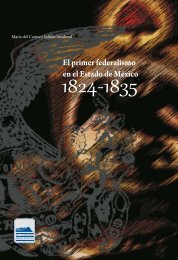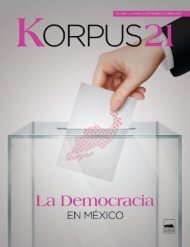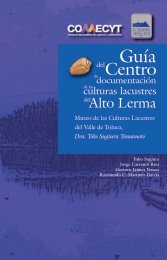You also want an ePaper? Increase the reach of your titles
YUMPU automatically turns print PDFs into web optimized ePapers that Google loves.
KORPUS <strong>21</strong>, VOL. 4, NÚM. <strong>10</strong>, 2024, 113-126<br />
as a Mexican historian, I knew some of the music,<br />
and as an American, I knew its US counterparts,<br />
but most of all I include myself because I shared<br />
their feelings. That provided me with a clue as to<br />
what my project might be about.<br />
During these gatherings, I came to appreciate<br />
the prodigious memory of Pepe Zúñiga, enriched<br />
by a sensitivity for images that marked him as<br />
a painter as well as an acute sense of sound<br />
(he had first trained as a radio technician and<br />
worked for RCA Victor). He shared his enthusiasm<br />
and intimate acquaintance with Afro Cuban<br />
rhythms which swept his neighborhood, the Colonia<br />
Guerrero in central Mexico City, in the 40s<br />
and 1950s. At the dinner table, Pepe and others<br />
recalled the movies they had seen and how they<br />
had seen them: crowds of children pushing into<br />
the weekend matinees to watch Flash Gordon,<br />
Snow White, Superman and Bambi, and Pedro<br />
Infante. They recalled how later, as they grew,<br />
they shared the wounds of the heart bared by<br />
young rebels James Dean, Montgomery Clift,<br />
and Marlon Brando, their depths of new feelings<br />
-of confusion, injustice, anger, love-. Each person<br />
at the table would recall their personal experiences<br />
until we had lit a bonfire of forgotten<br />
joys, fears, and tears. It was one evening when<br />
Pepe and cultural critic Carlos Monsiváis were<br />
belting tunes from the US Hit Parade broadcast<br />
in Mexico in those years, that Pepe approached<br />
me and asked me if I would write his biography.<br />
He said he had a story to tell. I immediately said<br />
yes, as his story struck me as the one I wanted.<br />
I needed to write about the education of the<br />
senses which now seemed to me to be a historically<br />
relevant process, one churning in the deep<br />
waters beneath the surface, one that romped in<br />
play, breathed a desire for freedom, a whispered<br />
challenge to authoritarianism, in its traveling currents<br />
of tenderness, of love received, denied,<br />
and given, of selfhood bequeathed, protected,<br />
threatened, and fought for.<br />
Pepe Zúñiga was a distinguished painter, but<br />
not an anointed one. He was a graduate of the<br />
prestigious Esmeralda painting school and a professor<br />
there. He had spent many years on scholarship<br />
in Paris. He exhibited widely and regularly.<br />
His painting seduced me, but it may not have<br />
had the historical importance his personal story<br />
suggested to me. That story he shared with me<br />
over almost twelve years of interviewing. I am<br />
the only biographer here delving into the experiences<br />
of a living person. Not all biographers of<br />
living persons succeed in reaching deep emotions<br />
that in turn may uncover the dynamics of<br />
a historical period: the biographer might not be<br />
looking for these, and the subject may not be<br />
open to sharing. Or, a deceased subject may reveal<br />
deep intimate emotion through his or her<br />
artistic works accessible to the biographer. In<br />
the case of Pepe, while his painting revealed his<br />
emotional erotic self, I was interested in the stories<br />
that had created this self, and Pepe overflowed<br />
with stories he was eager to share. As he<br />
dove into those deep waters, he took me with<br />
him. In recalling his experiences, Pepe was not<br />
afraid to cry as we both did watching films and<br />
listening to music or talking of his father. Nor did<br />
he hide his humiliations that marked his childhood<br />
as a poor boy as much as did exuberance,<br />
joy, and discovery. Here in this essay, I wish to<br />
share how we (I with him) constructed his story<br />
of an education of the senses that was not solely<br />
his own but with many variations, that of hundreds<br />
of others.<br />
Our interviews took place in his studio home<br />
in the Colonial Guerrero or at my home in Oaxaca<br />
and on car rides to and from those places.<br />
Originally structured, the interviews became<br />
a running conversation. He would bring many<br />
old movies he bought from a dealer in Tepito.<br />
We would watch a Paul Muni or Joan Crawford<br />
film and comment during and after the film. He<br />
would tell me in what context he had seen the<br />
movie, how he had understood it as a child and<br />
now, how his father had introduced him to these<br />
stars. I did not transcribe but rather took rapid<br />
notes on my computer. I did not show him the<br />
interviews but had him read a more legible final<br />
draft. Our conversations covered many themes:<br />
family, school, religion, radio, film, his years at<br />
the Esmeralda, his early painting and exhibits<br />
that is turn became book chapters. We used<br />
props to prompt recall: apart from the films<br />
seen or the music heard, we used school textbooks,<br />
published lyrics, many family photos,<br />
reviews of his early exhibits and of the plays<br />
he saw, and secondary works related to these<br />
topics, accessible ones to theoretically challenging<br />
studies. We walked through the streets<br />
of Carmen Alto where he first lived as a child<br />
in Oaxaca and those of the Colonia Guerrero<br />
115



![bicentenario_1[V2]](https://img.yumpu.com/68677971/1/167x260/bicentenario-1v2.jpg?quality=85)
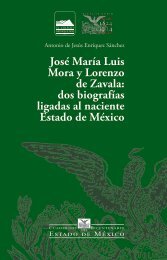
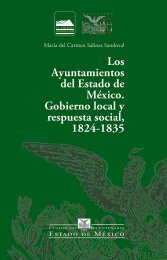

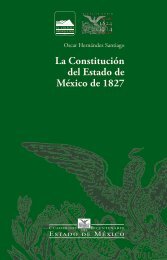
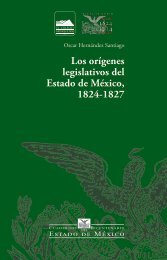
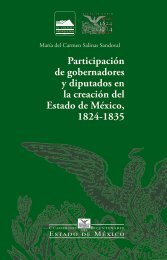
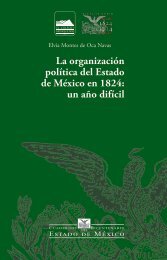
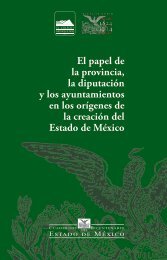
![El_primer_federalismoEM[final]_compressed (2)](https://img.yumpu.com/68483279/1/178x260/el-primer-federalismoemfinal-compressed-2.jpg?quality=85)
